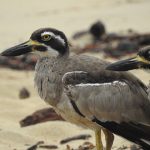BEACH STONE-CURLEW
The Beach Stone-curlew is a species of bird belonging to the family Burhinidae. It is also known by the common name “Beach Thick-knee.” The name “thick-knee” refers to the bird’s large and prominent joint on its leg, which gives it a distinctive appearance. Among shorebirds, the Beach Stone-curlew is one of the largest species. They can reach a height of about 50 to 55 cm and have a wingspan of up to 105 cm.
As the name suggests, the Beach Stone-curlew is often found in coastal areas, particularly sandy beaches, mudflats, and rocky shores of Australia and parts of Southeast Asia.
These birds are primarily nocturnal, meaning they are more active during the night, and they spend their days resting and camouflaging among rocks and sand. Their diet mainly consists of crustaceans, mollusks, insects, and small fish found along the shoreline.
The Beach Stone-curlew is considered vulnerable in some regions due to habitat loss, disturbance, and predation by introduced predators. Conservation efforts are ongoing to protect these unique and fascinating birds and their coastal habitats.
Beach Stone-curlews have evolved excellent camouflage that helps them blend in with their surroundings. During the day, they remain perfectly still among rocks, sand, or other beach debris, making them challenging to spot.
Their diet mainly consists of crustaceans, mollusks, small fish, and insects that they find in the intertidal zones of beaches and mudflats. With their large, strong bill, they can easily probe into sand or mud to catch prey.
The Beach Stone-curlew is considered a vulnerable species in some parts of its range, particularly in Australia. The destruction of coastal habitats, human disturbance, and predation by introduced predators are some of the threats it faces.
These birds are known for their loud and distinctive calls, especially during the breeding season. Their calls include a mix of haunting, eerie cries that add to their mystique.
Beach Stone-curlews form monogamous pairs during the breeding season. They build shallow scrapes in the sand where the female lays one or two eggs. Both parents take turns incubating the eggs and caring for the chicks.
Conservation status in NSW: Critically Endangered













